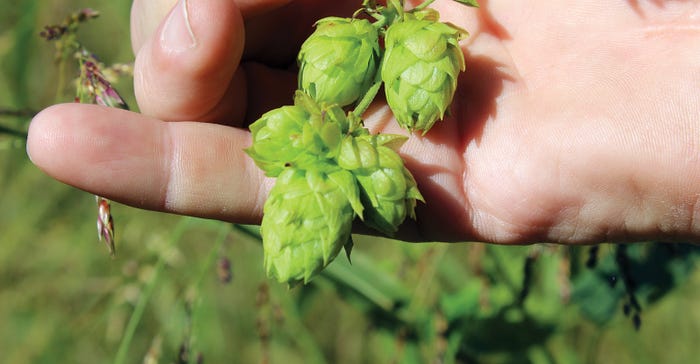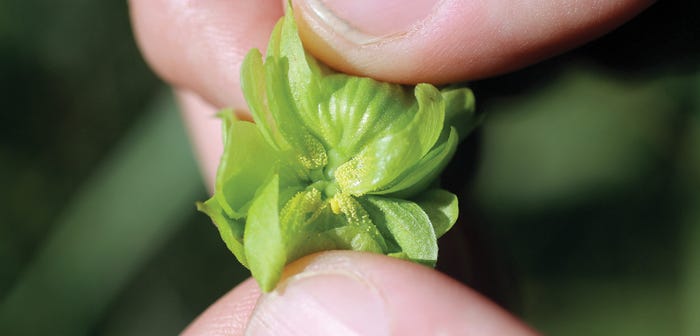
Bruce Kirksey crushes a mature hop “cone” between his fingers, lifts it toward his nose, sending his olfactory receptors into high gear, immediately associating the hop’s unmistakable odor to the distinct smell of beer.
Kirksey is the director of research at Agricenter International in Memphis, Tenn., which recently harvested its first crop of hops. Yes, hops. John Butler, Agricenter president, encouraged the idea of evaluating hops to capitalize on the growing trend of local microbreweries, the movement of eating locally-grown food, and the burgeoning desire of people to have a local flavor and taste in many aspects of their lives.
Local beers like Wiseacre and Ghost River, to Memphis Made (and my personal favorite) High Cotton, continue to endear consumer taste buds around the Mid-South to their unique and flavorful brews.
“Advancements in breeding have given us plants and cultivars that today break the boundaries of region-specific crop growth,” says Butler. “Barley has been grown in the Mid-South for hundreds of years for cattle feed, but malting barley is a new crop we want to evaluate.”
Agricenter International is known for its agricultural product/business development modeling concept. One of its goals has always been creating opportunities to increase diversity of local farming operations with minimal capital investment to increase farm-gate revenue.
The Agricenter makes a $524 million economic impact on the Mid-South region each year.

Dr. Bruce Kirksey, director of research, Agricenter International, holds a “bine” of mature hops from the Agricenter’s first-ever hop crop.
Getting Started
Kirksey grew five varieties offered by Great Lakes Hops. He planted five young plants of each variety that, based on his research, had the best chance for growth in the Mid-South’s environment.
“We decided to go with plants rather than rhizomes because plants grown from tissue culture are more disease-tolerant and prone to good plant health,” adds Kirksey. “Hops are a perennial crop, so this year we concentrated on cutting the vines back to promote strong root development.”
Hop roots grow 15 to 20 feet deep, and Kirksey is hopeful that type of robust root system will help plants tolerate Mid-South winter temperatures, as well as the brutal Southern summers.
Hops are typically grown in semi-arid regions. In the Pacific Northwest, they are irrigated and proliferate in the desert region of Washington. “Two of the five varieties we planted turned yellow and did absolutely nothing, so we know there are two varieties we can’t grow in the Delta,” says Kirksey.
Agricenter staff built the wooden/rope trellis system needed for the plant’s runners to climb. Young plants went into the ground around April 1, and hand harvesting began on Sept. 1.
“Vines feel rough to the touch, almost like Velcro, and they grow incredibly fast — almost 9 inches a day. You can almost see them climbing the trellis ropes,” adds Kirksey. “Varieties mature at different times, so harvest can be pretty spread out.”

Tiny yellow sacs called Lupulin glands are found near the base of the petals of a hop cone. They contain hop oils as well as alpha and beta acids, all key ingredients for brewing beer.
Economics, Pests and Problems
Pest pressure was almost non-existent this year, but Kirksey stands ready for that to change in year two. While there are registered products for pest control, he may try applying dormant oil that is often used on fruit trees. The oil sticks to a flying pest’s wings, preventing flight and egg lay. “It’s a good and safe way to get protection and is used on many ornamentals,” adds Kirksey.
Butler has been in contact with a few microbrewery owners who think purchasing hops and barley grown locally, beer made with water from the Memphis River Valley alluvial aquifer, and yeast from the Jackson, Miss., area would be an effective marketing angle.
“We’ve got to figure out how to get the hops processed into a manageable form. Most hops are delivered in pelletized form for easy handling and measuring.
A business plan is in the works and Butler is trying to evaluate if there are producers around the Mid-South willing to adopt hops into their operations. “We’ve got to devise a way to dry them down and achieve the appropriate moisture level demanded by the breweries,” says Butler. “It all requires an assembly line process from harvest and grading, to washing and packaging.”
Then there is the problem of malting the barley. An operation in North Carolina that will malt barley by the bushel. Malting requires wetting the barley to get the enzymes to activate the germination process. “You then have to stop the process at the right time,” adds Kirksey, “That’s very important.”
Their work will continue over the winter months through an experiment with 25 winter malting barley varieties to see how they mature. If they perform well, enjoying a cold beer made exclusively from products grown locally in the Mid-South could be in everyone’s future. Cheers!
About the Author(s)
You May Also Like




